#oberlin conservatory
Text

Congratulations to Rhiannon Giddens, who will deliver the keynote address at Oberlin College and Conservatory’s Class of 2024 Commencement ceremony on Monday, May 27, which will be livestreamed. Giddens, who studied opera at the Conservatory and graduated in 2000, will be awarded an Honorary Doctor of Music degree during the ceremony. "A consummate musician, equally noteworthy for her accomplishments as a performer, composer, scholar, lyricist, and more, Rhiannon Giddens stands as one of the most important creative and artistic voices of our time," Dean of the Conservatory William Quillen says. "Throughout her work, Giddens has brought to light previously overlooked or suppressed voices and histories.” Read more here.
#rhiannon giddens#oberlin college#oberlin conservatory#honorary doctorate#commencement 2024#nonesuch#nonesuch records
1 note
·
View note
Text
Björk album performer, UH music lecturer named Pulitzer finalist
Björk album performer, UH music lecturer named Pulitzer finalist
Anne Leilehua Lanzilotti
Finalist for the Pulitzer Prize in Music is the latest major accolade for a University of Hawaiʻi at Mānoa music lecturer. Kanaka Maoli (Native Hawaiian) musician, composer and scholar Anne Leilehua Lanzilotti was named one of two Pulitzer finalists for a composition called “with eyes the color of time.”
Eli Spindel conducts the viola section of the String Orchestra of…

View On WordPress
#art#college of arts languages and letters#contemporary museum#faculty recognition#Featured#honolulu museum of art#kanaka maoli#leilehua lanzilotti#manhattan school of music#manoa excellence in research#manoa native hawaiian place of learning#manoa research#Music#oberlin conservatory of music#pulitzer#pulitzer prize#string orchestra of brooklyn#uh manoa#university of hawaii#with eyes the color of time#yale school of music
0 notes
Text
Broadway Divas Tournament: Round 2A


Christine Baranski (1952)
"CHRISTINE BARANSKI (Charlotte) last appeared in the Playwrights Horizon’s workshop production of Stephen Sondheim’s Sunday in the Park with George. Just prior to that she appeared in the New York Shakespeare Festiva’s production of A Midsummer Night’s Dream for which she received an Obie Award. She also recently completed filming Louis Malle’s new movie Crackers in which she co-stars with Donald Sutherland. Other New York credits include Sally and Marsha with Bernadette Peters at the Manhattan Theatre Club; The Undefeated Rhumba Champ at the Ensemble Studio Theatre and Coming Attractions at Playwrights Horizons. Her films include Playing for Time with Vanessa Redgrave, Lovesick, and Soup for One. She has worked at Center Stage in Baltimore, Chicago’s Goodman Theatre and the McCarter Theatre in Princeton as well as the American Shakespeare Festival in Stratford, Connecticut. Christine is a graduate of the Julliard School and is the happy bride of actor Matthew Cowles.” – Playbill bio from The Real Thing, May 1984
Judy Kuhn (1958)
“JUDY KUHN (Alice/Succuba/Citizen/Miss Isabel Yearsley) is making her Broadway debut in Drood and was a member of the original company in Central Park last summer. Off-Broadway she received critical praise for her performance in the Jewish Repertory Theatre’s production of Pearls. Before that she was seen with Yul Brynner’s farewell tour of The King and I. Roles in stock productions include Maria in West Side Story, Julie in Carousel, Rosamund in The Robber Bridegroom. Judy is a graduate of the Oberlin Conservatory of Music and studies acting with John Stix.” – Playbill bio from The Mystery of Edwin Drood, April 1986.
NEW PROPAGANDA AND MEDIA UNDER CUT: ALL POLLS HERE

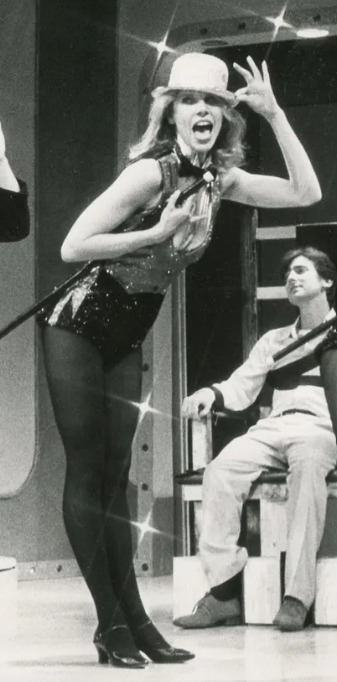

youtube
"With the devastating elimination of Patti LuPone, Christine Baranski may well be our reigning *Diva* in the most literal sense of the word. Are you truly worthy of the title if you don't inspire drag egos? Go on, close your eyes right now and picture a living Broadway Diva. Baranski is going to be on that list every time."



youtube
"Four-time Tony loser Judy Kuhn is a sad sentence to type. But hey, at least she's in good company with Elaine Stritch. Judy doesn't need a fancy trophy to prove how talented she is. She's booked and busy, and aren't we glad for it?"
#broadwaydivastournament#broadway#broadway divas#tournament poll#christine baranski#judy kuhn#round 2a
44 notes
·
View notes
Text
Walter Franklin Anderson
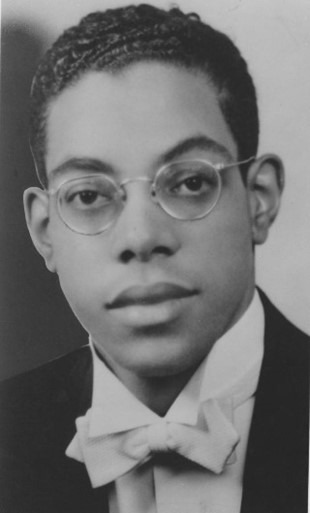
The grandson of formerly enslaved people, Walter Franklin Anderson, classical pianist, organist, composer, jazz musician, community activist, and academician, was born on May 12, 1915, in segregated Zanesville, Ohio. Walter was the sixth of nine children of humble beginnings.
Information regarding his parents is not available. Anderson, a child prodigy, began piano studies at age seven, and by 12, he was playing piano and organ professionally while still in elementary school. He was the only Black student to graduate from William D. Lash High School in Zanesville in 1932. Although a talented musician, Anderson was not a member of any of the school’s music ensembles, including the Glee Club or orchestra. Afterward, he enrolled in the Oberlin Conservatory of Music in Oberlin, Ohio, 100 miles north of his hometown, and received a Bachelor of Music in piano and organ in 1936. Anderson continued his studies at Berkshire (Tanglewood, the summer home of the Boston Symphony Orchestra) and the Cleveland Institute of Music in Cleveland, Ohio.
From 1939 to 1942, Anderson taught Applied Piano, Voice Pedagogy, and music theory at the Kentucky State College for Negroes (now Kentucky State University) in Frankfort. In 1943, Anderson married Dorothy Eleanor Ross (Cheeks) from Atlanta, Georgia. They parented two children, Sandra Elaine Anderson Mastin and David Ross Anderson, before the marriage ended in a divorce in 1945.
In 1946, Anderson was appointed the head of the music department at Antioch College in Yellow Springs, Ohio, thus becoming the first African American named to chair a department outside of the nation’s historically black colleges. Two years later, Anderson was a Rosenwald Fellow in composition from 1948 to 1949, where his variations on the Negro Spiritual, “Lord, Lord, Lord,” was performed by the Cleveland Orchestra. Moreover, John Sebastian, the conductor of the Orchestra, commissioned him to write “Concerto for Harmonica and Orchestra” for a performance with the same orchestra. In 1950, Anderson’s composition, “D-Day Prayer Cantata,” for the sixth anniversary of the World War II invasion, was performed on a national CBS telecast. In 1952, Anderson received the equivalent of a doctoral degree as a fellow of the American Guild of Organists. He left his administrative post at Antioch College in 1965.
In 1969, Anderson was named director of music programs at the National Endowment for the Arts, where he created model funding guidelines and pioneered the concept of the challenge grant. In addition, he spearheaded numerous projects and developed ideas at the then-new agency for supporting music creation and performance, specifically for orchestras, operas, jazz, and choral ensembles and conservatories.
Anderson was the recipient of four honorary doctorates in music over his professional career, including one from Berea College in Berea, Kentucky, in 1970. He retired from NEA in 1983. During this period, he became a presidential fellow at the Aspen Institute for Humanistic Studies and a recipient of the Cleveland Arts Prize for Distinguished Service to the Arts. In 1993, the American Symphony Orchestra League recognized Anderson as one of 50 people whose talents and efforts significantly touched the lives of numerous musicians and orchestras. He was also a member of the Advisory Council to the Institute of the Black World at the Martin Luther King, Jr. Memorial Center.
https://www.blackpast.org/african-american-history/people-african-american-history/walter-franklin-anderson-1915-2003/
25 notes
·
View notes
Text
By: Michael Shermer
Published: Mar 22, 2016
The French political journalist and supporter of the Royalist cause in the French Revolution, Jacques Mallet du Pan, famously summarized what often happens to extremists: “the Revolution devours its children.” I was thinking about this idiom—and its doppelgänger “what goes around comes around”—while writing a lecture for a talk I was invited to give at my alma mater California State University, Fullerton on the topic: “Is freedom of speech harmful for college students?” The short answer is an unflinching and unequivocal “No.”
Why is this question even being asked? When I was in college free speech was the sine qua non of the academy. It is what tenure was designed to protect! The answer may be found in the recent eruptions of student protests at numerous American colleges and universities, including Amherst, Brandeis, Brown, Claremont McKenna, Oberlin, Occidental, Princeton, Rutgers, University of California, University of Missouri, Williams, Yale, and others. Most of these paroxysms were under the guise of protecting students from allegedly offensive speech and disagreeable ideas—defined differently by different interest groups—with demands for everything from trigger warnings and safe spaces to microaggressions and speaker disinvitations.
Between the 1960s and the 2010s, what went wrong?

[ Students at Rutgers University protest a talk by Milo Yiannopoulos by smearing red on their faces and shouting “hate” when he challenged them to hear other points of view. ]
The Problem
Trigger warnings are supposed to be issued to students before readings, classroom lectures, film screenings, or public speeches on such topics as sex, addiction, bullying, suicide, eating disorders, and the like, involving such supposed prejudices as ableism, homophobia, sizeism, slut shaming, transphobia, victim-blaming, and who-knows-what-else, thereby infantilizing students instead of preparing them for the real world where they most assuredly will not be so shielded. At Oberlin College, for example, students leveled accusations against the administration of imperialism, white supremacy, capitalism, and the ne plus ultra in gender politics, cissexist heteropatriarchy, the enforcement of “gender binary and gender essentialism” against those who are “gender variant (non-binary) and trans identities.” The number of such categories has expanded into an alphabet string, LGBTQIA, or lesbian, gay, bisexual, trans, queer/questioning, intersex, asexual and any other underrepresented sexual, gender, and/or romantic identities.1 This is not your parents’ protest against Victorian sexual mores, and the list of demands by Oberlin students would be unrecognizable to even the most radical 60’s hippies:
The creation of a school busing system for Oberlin, Ohio’s K–12 schools, paid for by the college.
The establishment of special, segregated black-only “safe spaces” across campus.
A more inclusive audition process in the Conservatory that does not privilege Western European theoretical knowledge over playing ability.
The creation of a bridge program that will recruit recently-released prisoners to enroll at Oberlin for undergraduate courses.
The most audacious demand was “an $8.20/hour stipend for black student leaders who are organizing protest efforts.” These students wanted to be paid for protesting!
As often happens in moral movements, a reasonable idea with some evidentiary backing gets carried to extremes by engaged moralists eager for attention, sympathy, and the social standing that being a victim or victim sympathizer can bring. Soldiers suffering from PTSD, for example, may be “triggered” by the backfire of a nearby automobile, but no one has proposed that automobile manufacturers put “trigger warnings” on cars to accommodate soldiers. As well, the Harvard psychologist Richard McNally points out that trigger warnings may have the opposite effect for which they are intended, because “systematic exposure to triggers and the memories they provoke is the most effective means of overcoming the disorder.” McNally sites an analysis by the Institute of Medicine, which found that “exposure therapy is the most efficacious treatment for PTSD, especially in civilians who have suffered trauma such as sexual assault.” In other words, face your problems head-on and deal with them. An additional problem with trigger warnings is that the number of triggers has expanded to the point where nearly every speech and lecture could contain triggering words, turning communication into a moral hazard. Finally, who determines what is “triggering” anyway? The very concept is a recipe for censorship.
Safe space, according to the organization Advocates for Youth, is “A place where anyone can relax and be fully self-expressed, without fear of being made to feel uncomfortable, unwelcome or challenged on account of biological sex, race/ethnicity, sexual orientation, gender identity or expression, cultural background, age, or physical or mental ability; a place where the rules guard each person’s self-respect, dignity and feelings and strongly encourage everyone to respect others.” Some such places even contain pillows, soothing music, milk and cookies, and videos of puppies.
In addition to infantilizing adults, this practice often means protecting students from opinions that they don’t happen to agree with, or shielding them from ideas that challenge their beliefs, which has always been one of the most valuable benefits of a college education. In any case, college campuses, along with the cities and states they’re in, are already designed to be safe from violence and discrimination based on the rule of law enforced by the police and courts. In point of fact, most of these colleges nestled in American cities are among the safest places on earth. If you want to build a safe space for people who really need it, go to Syria or Somalia. And if this opinion triggers you or makes you feel unsafe then you haven’t been paying attention to what’s going on in the world.
Microaggressions are comments or questions that slight, snub, or insult someone, intentionally or unintentionally, in anything from casual conversation to formal discourse. According to the University of California publication Tool: Recognizing Microaggressions and the Messages They Send, examples include:
Asking, “Where are you from or where were you born?” or “What are you?” This implies someone is not a true American.
Inquiring, “How did you become so good in math?” (to people of color) or suggesting “You must be good in math” (to an Asian), which is stereotyping.
Proclaiming, “There is only one race, the human race” or “I don’t believe in race.” This denies the significance of a person of color’s racial/ethnic experience and history.
Opining, “I believe the most qualified person should get the job” or “America is the land of opportunity.” This suggests that the playing field is level, so if women or people of color do not fill all jobs and careers in precise proportion to their population percentages, it must mean that the problem is with them, or that they are lazy or incompetent and just need to work harder.

[ Tool: Recognizing Microaggressions and the Messages They Send (click image to enlarge) ]
Yes, language matters, and some comments that people make are cringe worthy (e.g., saying “you people” to a group of African Americans, or “you’re a girl, you don’t have to be good at math”). But do we really need a list of DOs and DON’Ts handed out to students and reviewed like they were five-year olds being taught how to play nice with the other kids in the sandbox? Can’t adults work out these issues themselves without administrators stepping in as surrogate parents? And who determines what constitutes “hate,” “racist” or “sexist” speech? Who it happens to bother or offend? Students? Faculty? Administration? And as with the problem of trigger words, the list of microaggressions grows, turning normal conversation into a cauldron of potential violations that further restricts speech, encourages divisiveness rather than inclusiveness, and forces people to censor themselves, dissemble, withhold opinion, or outright lie about what they believe.
An incident at Brandeis University in 2015 is instructive: when Asian American students installed an exhibition on microaggressions, other Asian American students claimed that the exhibit was itself a microaggression that triggered negative feelings, leading the president to issue an apology to anyone “triggered or hurt by the content of the microaggressions.” Agreed, blurting out “Why do you Asians always hang out together” is lame, but at this point in history it just makes the communicant sound more like a bore than a bigot, and more deserving of eye rolls than public humiliation.
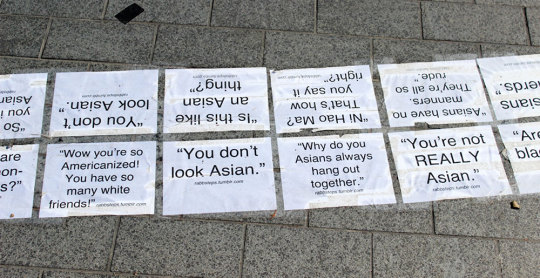
[ Brandeis University microagression display, later declared a microagression (click image to enlarge) ]
Speaker disinvitations—cancellations of invited speakers—have been accelerating over the past decade. According to the Foundation for Individual Rights in Education (FIRE), 257 such incidents have occurred since 2000, 111 of which were successful in preventing the invited guests from giving their talks. In 2014, for example, Ayaan Hirsi Ali was invited to give the commencement speech at Brandies University, where she was to also receive an honorary doctorate. After students protested, citing her criticism of Islam for its mistreatment of women, the administration caved into their demands and Ali was no-platformed (as it is called in England). Worse, in this theater of the absurd, students from U.C. Berkeley attempted to no-platform the comedian and social commentator Bill Maher for his alleged “Islamophobia,” code for anyone who criticizes Islam for any reason. Maher delivered his commencement oration nonetheless, telling the very liberal student body that “Liberals should own the First Amendment the way conservatives own the Second Amendment,” pointing out that apparently irony is no longer taught at this birthplace of the 1960’s free speech movement. This was topped by students at Williams College who, in October 2015, succeeded in disinviting Suzanne Venker, author of The Flipside of Feminism. Venker was invited to participate in the college’s “Uncomfortable Learning” lecture series but, well, she made some students feel too uncomfortable. “When you bring a misogynistic, white supremacist men’s rights activist to campus in the name of ‘dialogue’ and ‘the other side,’” whined one student on Facebook, it causes “actual mental, social, psychological, and physical harm to students.” Physically harm?
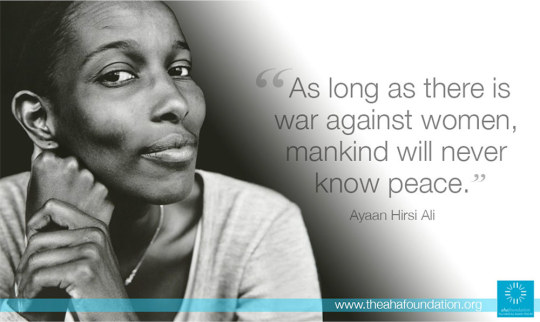
[ Banner from the website of Ayaan Hirsi Ali ]
The effects of such protests are often the opposite of what the protesters sought. Ayaan Hirsi Ali’s speech, for example, was printed in the Wall Street Journal where it was seen by that paper’s 2.37 million readers, many orders of magnitude more than would have heard it on campus. Bill Maher turned his Berkeley brouhaha into a bit for his HBO television show Real Time, which carries over four million viewers. More irony.
What may have started out as well intentioned actions at curbing prejudices and attenuating bigotry with the goal of making people more tolerant, has now metamorphosed into thought police attempting to impose totalitarian measures that result in silencing dissent of any kind. The result is the very opposite of what free speech and a college education is all about.
Why such unrest in the academy—among the most liberal institutions in the country—surrounded as these students are by so many liberal professors and administrators? Here I will offer five proximate (immediate) causes, one ultimate (deeper) cause, and some solutions.
Proximate Causes
1. Moral Progress
As I document in The Moral Arc, we have made so much moral progress since the Enlightenment—particularly since the civil rights and women’s rights movements that launched the modern campus protest movement in the first place—that our standards of what is tolerable have been ratcheted ever upward to the point where students are hypersensitive to things that, by comparison, didn’t even appear on the cultural radar half a century ago. This progress has happened gradually enough on the news cycle measure of days and weeks to be beneath the awareness of most observers, but fast enough that it can be tracked on time scales ranging from years to decades. For example, remember when interracial marriage was a divisive debate? Me neither. But recall the now-jarring words of the trial judge Leon M. Bazile, who convicted Richard and Mildred Loving in the case (Loving v. Virginia) that ultimately made its way to the Supreme Court in 1967 and overturned laws banning interracial marriage: “Almighty God created the races white, black, yellow, malay and red, and he placed them on separate continents. The fact that he separated the races shows that he did not intend for the races to mix.” Same-sex marriage went through a similar evolution as interracial marriage, culminating in the 5–4 decision by the Supreme Court of the United States in 2015 to make same-sex marriage the law of the land, another data point in the long-term trend toward granting more rights to more people.
Interracial marriage and same-sex marriage are themselves the legacy of the rights revolutions that first took off in the late 1700s when the idea of rights was invented and then demanded, first in the American Revolution (starting with the Declaration of Independence in 1776), then in the French Revolution (with the Declaration of the Rights of Man and of the Citizen in 1789), inspiring subsequent rights revolutions and documents (for example, Declaration of the Rights of Woman in 1791). The result, two and a half centuries later, has been the abolition of slavery, the eradication of torture, the elimination of the death penalty in all modern democracies save America, the franchise for all adult citizens, children’s rights, women’s rights, gay rights, animal rights, and even the rights of future generations to inhabit a livable planet. Who knows, perhaps one day soon we’ll even grant rights to Artificially Intelligent robots. In other words, most of the big moral movements have been fought and won, leaving today’s students with comparatively smaller causes to promote and evils to protest, but with moral emotions just as powerful as those of previous generations, so their outrage seems disproportionate.
2. Transition from a Culture of Honor to a Culture of Victimhood
In a culture of honor one settles minor disputes oneself and leaves the big crimes to the criminal justice system. Over the past two decades this has been eroded and is being replaced by a culture of victimhood in which one turns to parent-like authorities (faculty and college administrators, but not the law) to settle minor disputes over insults and slights.2 The culture of honor leads to autonomy, independence, self-reliance, and self-esteem, whereas the culture of victimhood leads to dependence and puerile reliance on parental figures to solve ones’ problems. In this victimhood culture the primary way to gain status is to either be a victim or to condemn alleged perpetrators against victims, leading to an accelerating search for both.3 A student at the University of Oxford named Eleanor Sharman explained how it happened to her after she joined a campus feminist group named Cuntry Living and started reading their literature on misogyny and patriarchy:
Along with all of this, my view of women changed. I stopped thinking about empowerment and started to see women as vulnerable, mistreated victims. I came to see women as physically fragile, delicate, butterfly-like creatures struggling in the cruel net of patriarchy. I began to see male entitlement everywhere.
As a result she became fearful and timid, afraid even to go out to socialize:
Feminism had not empowered me to take on the world—it had not made me stronger, fiercer or tougher. Even leaving the house became a minefield. What if a man whistled at me? What if someone looked me up and down? How was I supposed to deal with that? This fearmongering had turned me into a timid, stay-at-home, emotionally fragile bore.
It is not that there are no longer real victims of actual crimes, but it is a disservice to them to equate the trivial peccadillos of microaggressions or triggering words with brutal rapes and murders. A feminist named Melody Hensley, for example, who was once the Executive Director of the Center for Inquiry in Washington DC. claims that years of online stalking and social media trolls gave her PTSD on par with that of combat soldiers, disabling her from being able to work. Not surprisingly, war vets were not sympathetic.
3. From Anti-Fragile to Fragile Children
One response to the 1970s and 1980s crime wave was a shift toward “helicopter parenting” in which children were no longer allowed to be, well, children. The social psychologist Jonathan Haidt explains why through the concept of anti-fragility: “Bone is anti-fragile. If you treat it gently, it will get brittle and break. Bone actually needs to get banged around to toughen up. And so do children. I’m not saying they need to be spanked or beaten, but they need to have a lot of unsupervised time, to get in over their heads and get themselves out. And that greatly decreased in the 1980s. Anxiety, fragility and psychological weakness have skyrocketed in the last 15–20 years.” Those kids are today’s college students, and as a consequence they have brittle bones and thin skins. An example of an anti-fragile person with strong bones and thick skin is the model Isabelle Boemeke, who tweeted what she does when verbally harassed on the streets by ogling men:
Here’s what I do when catcalled: roll my eyes, if he’s Hispanic say “chinga tú madre!”, put earphones on, continue with life.
— Isabelle Boemeke (@isaboemeke) February 10, 2016
4. Puritanical Purging
Social movements tend to turn on themselves in puritanical purging of anyone who falls short of moral perfection, leading to preemptive denunciations of others before one is so denounced. The witch crazes of the 17th century degenerated into such anticipatory condemnations, resulting in a veritable plethora of nonexistent sorceresses being strapped to faggots and torched. The 20th century witnessed Marxist and feminist groups undergoing similar purges as members competed for who was the purist and defenestrated those who fell below the unrealizable standard. On the other side of the political spectrum, Ayn Rand’s objectivist movement took off in a frenzied build up after the publication of Atlas Shrugged in 1959, but by the time the philosopher-novelist died in 1982 most of the insider “collective” had been expunged for various sins against the philosophy, from listening to the wrong music to challenging the founder on any point of substance or minutia. Such purification purges are among the worst things that can happen to a social movement.
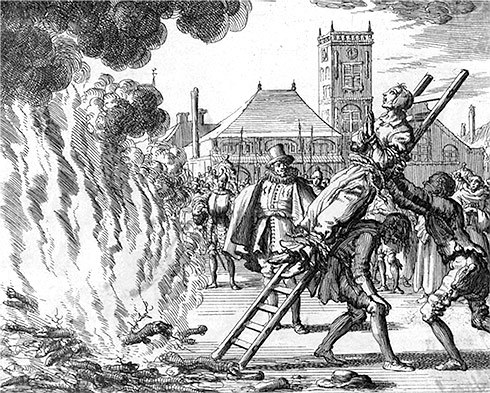
[ Pre-emptive denunciations lead to witch hunts. ]
5. Virtue Signaling
Related to puritanical purging is virtue signaling, in which members of a movement compete to signal who is the most righteous by (A) recounting all the moral acts one has performed and (B) identifying all the immoral acts others have committed. This leads to an arms-race to signal moral outrage over increasingly diminishing transgressions, such as unapproved Halloween costumes at Yale University, which led to a student paroxysm against a faculty member, a cell-phone video of which went viral and nearly brought the campus to a stand still. This is an example of what Maajid Nawaz means by “regressive liberalism,” where freedom of speech and expression are sacrificed in the name of tolerance, which is actually intolerance. One of the first acts of totalitarian regimes is to restrict dissent and free speech, so perhaps it should be called totalitarian liberalism.
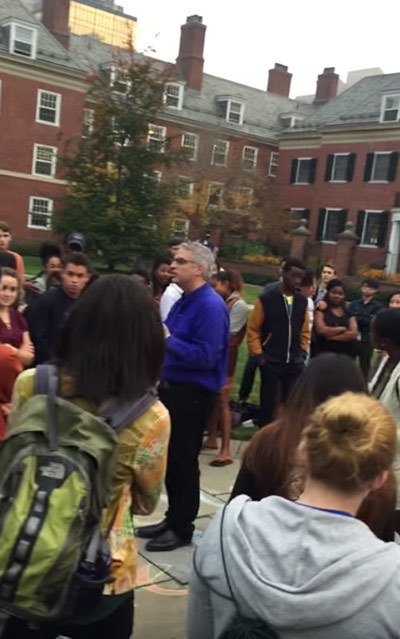
[ Yale college master Nicholas Christakis (in blue shirt) is verbally assaulted by a student who accused him of not doing enough to censor the wearing of Halloween costumes that could be seen as offensive. “Who the fuck hired you?” the girl with the backpack screamed at the professor. ]
An Ultimate Cause
A deeper reason behind the campus problem is a lack of diversity. Not ethnic, race, or gender diversity, but viewpoint diversity, specifically, political viewpoint. The asymmetry is startling. A 2014 study conducted by UCLA’s Higher Education Research Institute found that 59.8 percent of all undergraduate faculty nationwide identify as far left or liberal, compared with only 12.8 percent as far right or conservative. In a 2015 study published in Behavioral and Brain Sciences Arizona State University psychologist José Duarte and his colleagues reported that 58–66 percent of social science professors identify as liberals, compared to only 5-8 percent as conservatives. Given the power of beliefs to drive actions, college students today stand next to no chance of receiving a balanced education on the most important topics of our time and for which social science is best equipped to study.
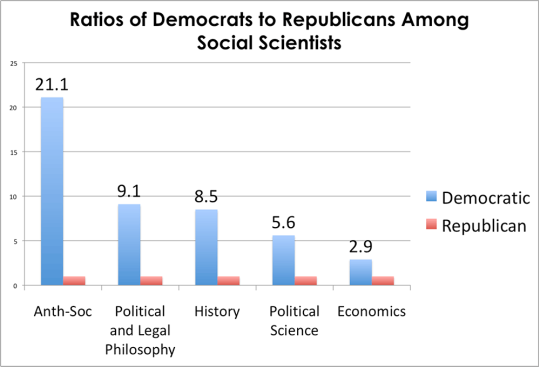
[ This graph captures the political bias problem well. From: Klein, Daniel B. and Charlotte Stern. “Professors and Their Politics: The Policy Views of Social Scientists.” Critical Review, 17, p. 264. (click image to enlarge) ]
What goes around comes around. Today’s liberal college professors were radical college students in the 1960s and 1970s, protesting “the man” and bucking authority. One reason faculty and administrators are failing to stand up to student demands today is that they once wore those shoes. Raising children and students to be dismissive of law and order and mores and manners leads to a crisis in consciousness and the rejection of the very freedoms so hard won by their parents and teachers. A generation in rebellion gave birth to a generation in crisis. Thus it is that the revolution devours its children.
Solutions
There is no magic bullet solution to the problems the academy faces today, but as liberals have known for some time it takes decades—even generations—to right the wrongs of the past, so solutions are likely to be incremental and gradual, which is almost always a good thing when it comes to social change, as it leads to less violent and more peaceful actions on the part of both activists and their opponents. Contra Barry Goldwater, extremism in the defense of liberty is no virtue; moderation in the pursuit of justice is no vice.4
Hiring practices fall under this rubric. If the academy is already comfortable with and active in seeking to diversify its faculty by ethnicity, race, and gender, why not viewpoint as well? Given the entrenchment of tenure this will take time, but as that scribe of moral progress Victor Hugo observed, “Nothing is more powerful than an idea whose time has come.”5
In the meantime, viewpoint diversity can be increased almost overnight by inviting speakers from a wide range of perspectives—political, economic, and ideological—even if (or especially) if they are offensive to faculty and students. And no more disinvitations! If you invite someone to speak, honor your word, own your decision, and stand up to the cry bullies (as they’re called in this neologism). The assignment of books and papers for students to read—especially for courses in history, English literature, the humanities, and the social sciences—can and should include authors whose positions are at odds with those of most academicians and student bodies. And professors: in addition to assigning students articles and opinion editorials from the New York Times, give them a few from the Wall Street Journal. Balance The Nation magazine with Reason magazine, The American Prospect with The American Spectator, National Public Radio with Conservative Talk Radio, PBS with Fox News.
Viewpoint diversity, however, is subservient to the deeper principle of free speech, which should be applied indiscriminately across the academy, as it should across society and, ideally, the world. What does free speech mean? First, it does not mean that you can lie about someone. Libel laws are in place to protect people from defamation that causes reputational and financial harm. Second, free speech does not mean that the government, public institutions, or private persons, businesses, or publications are required to promote or publish the opinions of others. As the Publisher of Skeptic magazine, for example, it is not incumbent on me to publish articles or accept advertisements just because we’re in the business of publishing. Institutions should have the freedom to restrict the speech of anyone who utilizes resources within the jurisdiction of its own institution, such as a school newspaper. The government, however, cannot restrict citizens’ speech just because it finds their opinions distasteful, offensive, or critical of its policies. (Exceptions have been made for treason and the passing on of national secrets to enemies, but crying “fire” in a crowded theater was most likely an exception that proves the rule.)
Holocaust deniers, creationists, and 9/11 truthers, for example, should have the right to publish their own journals and books, and to attempt to have their views aired in other publications and media venues, as in college newspapers and web sites, but no one is obligated to publish them. Alex Grobman and I wrestled with the free speech issue in our 2004 book Denying History: Who Says the Holocaust Never Happened and Why Do They Say It? As we opined: “Being in favor of someone’s right to freedom of speech is quite different from enabling that speech.” But we chose to write a book about their movement and arguments, quoting them extensively because, we believe, “In the bright light of open discussion the truth will emerge.”6 And although I declined to publish an ad submitted by a Holocaust denier in Skeptic (running an advertisement in our magazines carries the imprimatur of endorsement), I did debate Mark Weber, the director of the Institute for Historical Review (the leading Holocaust denier organization) in a public forum they hosted.
The freedom of speech has been one of the driving forces behind moral progress because it enables the search for truth. How? There are at least five reasons:7
We might be completely right but still learn something new.
We might be partially wrong and by listening to other viewpoints we might stand corrected and refine and improve our beliefs. No one is omniscient.
We might be completely wrong, so hearing criticism or counterpoint gives us the opportunity to change our minds and improve our thinking. No one is infallible. The only way to find out if you’ve gone off the rails is to get feedback on your beliefs, opinions, and even your facts.
Whether right or wrong, by listening to the opinions of others we have the opportunity to develop stronger arguments and build better facts for our positions. You know that the world is round and goes around the sun, that evolution is real, and that the Holocaust happened. But can you explain how you know these facts? What are the best arguments and evidences for these facts? Could you articulate them clearly and succinctly in a debate or conversation? As John Stuart Mill noted in his classic 1859 work On Liberty: “He who knows only his own side of the case, knows little of that.”
My freedom to speak and dissent is inextricably tied to your freedom to speak and dissent. Once customs and laws are in place to silence someone on one topic, what’s to stop people from silencing anyone on any topic that deviates from the accepted canon? The justification of censorship laws in the consequentialist argument that people might be incited to discrimination, hate, or violence if exposed to such ideas fails the moment you turn the argument around and ask: What happens when it is you and your ideas that are determined to be dangerous? It is the Principle of Interchangeable Perspectives that I introduced in The Moral Arc: For me to expect you to listen to me I must be willing to hear you. If I censor you, why shouldn’t you censor me? If you silence me, why shouldn’t I silence you?
This argument against censorship was well articulated in Robert Bolt’s 1960 play, A Man for All Seasons, based on the true story of the 16th century Chancellor of England, Sir Thomas More, and his collision with King Henry VIII over the monarch’s divorce from Catherine of Aragon. In the play a dialogue unfolds between More and his future son-in-law Roper, who urges him to arrest a man whose testimony could condemn More to death, even though no laws were broken. “And go he should, if he were the Devil himself, until he broke the law!” More entices.
Roper: So now you’d give the Devil benefit of law!
More: Yes. What would you do? Cut a great road through the law to get after the Devil?
Roper: I’d cut down every law in England to do that.
More: Oh? And when the law was down, and the Devil turned round on you—where would you hide, Roper, the laws all being flat? This country is planted thick with laws from coast to coast…and if you cut them down…do you really think you could stand upright in the winds that would blow then? Yes, I’d give the Devil benefit of law, for my own safety’s sake.8
For our own safety’s sake we must grant our devils their due.
#Michael Shermer#academic corruption#student fragility#emotional fragility#censorship#trigger warnings#speech codes#academic freedom#freedom of speech#free speech#academic integrity#long post#religion is a mental illness
16 notes
·
View notes
Text
LÉGENDES DU JAZZ
CLORA BRYANT, ‘’THE WOMAN WITH THE HORN’’
“Those male trumpet players guard those positions like a bulldog on a bone. We got a tough row to hoe with the trumpet.”
- Clora Bryant
Née le 30 mai 1927 à Denison, au Texas, Clora Larea Bryant était la plus jeune des trois enfants de Charles et Eulila Bryant. Bryant avait deux frères, Frederick et Melvin. Le père de Bryant était manoeuvre et sa mère était maîtresse de maison. Bryant avait seulement trois ans lorsqu’elle avait perdu sa mère.
Bryant avait d’abord commencé à apprendre le piano avec son frère Melvin. Bryant avait adopté la trompette après que son high school ait décidé d’établir un orchestre et un ensemble de cors et clairons. Durant son enfance, Bryant avait aussi été membre de la chorale de l’église baptiste locale. Même s’il était peu fortuné, le père de Bryan l’avait toujours encouragée à devenir musicienne et lui avait même payé des cours privés. Comme Bryant l’avait expliqué plusieurs années plus tard, "Nobody ever told me, 'You can't play the trumpet, you're a girl.' Not when I got started in high school and not when I came out to L.A. My father told me, 'It's going to be a challenge, but if you're going to do it, I'm behind you all the way.' And he was."
Lorsque son frère Fred s’était joint à l’armée, il avait laissé sa trompette derrière lui, et Bryant en avait profité pour apprendre à jouer. Durant ses études au high school, fascinée par la musique de jazz qu’elle entendait à la radio, Bryant avait d’ailleurs joué de la trompette avec l’ensemble de cors et clairons de l’école.
Après avoir refusé des bourses pour aller étudier dans les meilleures écoles musicales au pays dont le Oberlin Conservatory et le Bennett College, Bryant avait commencé à fréquenter le Prairie View College de Houston en 1943. Fondée en 1876, Prairie View était la première école entièrement réservée aux étudiants de couleur à avoir été reconnue par l’État du Texas. Bryant avait choisi Prairie View parce que le collège avoir avait un groupe de jazz féminin de seize membres, les Prairie View Co-eds. Comme Bryant l’avait précisé plus tard: “When I found out they had an all-girl band there, that’s where I was going.”
Devenue membre du groupe, Bryant avait fait le tour du Texas, avant de se produire au célèbre Apollo de Harlem en 1944. Après que son père ait décroché un emploi dans un chantier naval de Los Angeles, Bryant avait été transférée à UCLA en 1945. Après avoir entendu le trompettiste Howard McGhee jouer au club Down Beat de la Central Avenue, Bryant était immédiatement tombée amoureuse du bebop.
DÉBUTS DE CARRIÈRE
En 1946, Bryant s’était jointe aux International Sweethearts of Rhythm, un big band qui avait été fondé deux ans auparavant par Clarence Love et qui était alors le groupe de swing féminin le plus important au pays. Après avoir obtenu sa carte de l’Union des musiciens, Bryant avait finalement décidé d’abandonner l’université.
Fascinée par le bebop, Bryant avait laissé tomber les International Sweethearts of Rhythm pour se joindre à des jam sessions dans des clubs de Central Avenue comme le Club Alabam, The Downbeat et The Bird in the Basket (aussi connu sous le nom de Jack’s Basket Room). Comme Bryant l’avait expliqué des années plus tard dans le cadre d’une entrevue d’histoire orale: “I would not go without my horn. If I knew there was going to be somebody there, I’d have my horn with me, because I wanted to be a part of it. I wanted to try to learn something.” Un jour, Bryant se produisait dans un club d’Hermosa Beach lorsque Charlie Parker était monté sur scène avec un saxophone qu’il avait emprunté. Pour la mettre en confiance, Parker lui avait alors chuchoté à l’oreille: “Stick to what you can do. And know what you can’t.” “I almost wet my pants”, avait déclaré plus tard Bryant.
Par la suite, Bryant était entrée dans le groupe Queens of Swing (comme batteuse) et était partie en tournée avec la formation. En 1951, le groupe, qui comprenait la saxophoniste Minnie Hightower, s’était produit à la télévision sous le nom des Hollywood Sepia Tones dans le cadre d’une émission de variétés d’une demi-heure diffusée sur les ondes de la station KTLA. La formation était ainsi devenue le groupe de jazz féminin à faire une apparition à la télévision. L’émission avait finalement été annulée auprès six semaines faute de commanditaires. À l’époque du tournage de l’émission, Bryant était enceinte de sept ou huit mois. Après la naissance de sa fille, Bryant s’était jointe à la revue entièrement féminine d’Ada Leonard. Malheureusement, Bryant avait dû quitter la revue après seulement une semaine après que la direction ait reçu des plaintes des spectateurs réclamant son congédiement en raison de la couleur de sa peau...
Durant la majeure partie des années 1950, Bryant avait dirigé régulièrement des jam sessions dans les environs de Los Angeles. En 1951, Bryant avait fait partie du groupe-maison du club Alabam, ce qui lui avait permis d’accompagner des chanteuses comme Josephine Baker et Billie Holiday. Toujours en 1951, Bryant avait été membre d’un sextet entièrement féminin dirigé par Ginger Smock avec lequel elle avait joué, non de la trompette, mais du violon. Le groupe, qui s’était produit durant six semaines dans le cadre d’une émission diffusée sur le réseau CBS, était ainsi devenu le premier groupe entièrement de couleur à animer une émission de télévision.
En 1954, Bryant était retournée à New York, car elle n’avait plus le goût de jouer avec des groupes. Deux ans plus tard, une autre pionnière du jazz féminin, la tromboniste Melba Liston, qui faisait alors partie du groupe de Dizzy Gillespie, l’avait présenté à ce dernier. Ébloui par le talent de Bryant, Gillespie était devenu son mentor et lui avait obtenu du travail. Gillespie avait même fait cadeau à Bryant d’une de ses embouchures qu’elle avait utilisée par la suite durant des années. Comme Gillespie l’avait expliqué en 1989 dans le documentaire “Trumpetistically, Clora Bryant”: “If you close your eyes, you’ll say it’s a man playing. She has the feeling of the trumpet. The feeling, not just the notes.”
En 1957, Bryant avait enregistré son premier et seul album comme leader, ‘’Gal with a Horn’’ À la demande de la compagnie de disques Mode Records, mais contre son gré, Bryant avait chanté sur les huit pièces de l’album, même si c’est son talent à la trompette qui avait surtout impressionné, révélant les influences tant de Louis Armstrong que de pionniers du bebop comme Dizzy Gillespie et Fats Navarro. Pour obtenir plus de contrats, Bryant avait même commencé à imiter la voix d’Armstrong dans le cadre de ses concerts. Et ça avait fonctionné. Comme Bryant l’avait expliqué en 2014 dans le cadre du documentaire The Girls in the Band: “And I was a hit, honey. They loved me!”
Au milieu des années 1950, Bryant était retournée à la vie de musicienne itinérante, se produisant particulièrement dans les clubs de Chicago et de Denver. Bryant s’était également produite à Las Vegas avec Louis Armstrong et Harry James. En fait, Armstrong avait été tellement impressionné après avoir entendu Bryant jouer dans un club qu’il avait insisté pour monter sur scène avec elle dans un club de Las Vegas en 1960. Bryant précisait: “He was in the big room and I was in the lounge, where he’d been catching my act in the back. And one day, here comes Louis with his whole band, coming from the big room, walking through the entire casino and coming up on stage and singing and playing with me!”
À la fin des années 1950 et durant les années 1960, Bryant avait fait la tournée des principales villes américaines, souvent dans le cadre d’un hommage à Louis Armstrong. À Las Vegas, Bryant avait aussi joué avec Damita Jo, Harry James, et Sammy Davis Jr., avec qui elle avait fait une apparition dans le film ‘’Pepe’’ en 1960. Dans les années 1960, Bryant avait également fait un séjour à La Nouvelle-Orléans avec le groupe d’Horace Henderson.
De 1962 à 1964, Bryant avait collaboré avec le chanteur Billy Williams à Las Vegas avec qui elle avait participé au Ed Sullivan Show. Bryant avait même composé une pièce de l’album “The Billy Williams Revue.” De 1964 à 1966, Bryant avait fait équipe avec son frère Melvin, qui était chanteur, acteur et danseur, dans le cadre d’une tournée autour du monde. Ils avaient même eu leur propre émission de télévision en Australie. Après la naissance de son quatrième enfant en 1969, Bryant s’était inscrite à un baccalauréat en musique à UCLA, s’intéressant plus particulièrement à l’histoire de la musique afro-américaine.
À la fin des années 1970, Bryant s’était produite avec différents groupes de Los Angeles, dont le Bill Berry’s LA Band. En 1975, Bryant avait rendu hommage à son idole et mentor Dizzy Gillespie dans le cadre de la suite “To Dizzy with Love”. En 1993, Bryant avait de nouveau rendu hommage à Gillespie en dirigeant le concert Trumpet Summit aux côtés de Clark Terry, Jon Faddis, Freddie Hubbard et plusieurs autres trompettistes. Vers 1980, Bryant avait également assuré la relève de Blue Mitchell dans le big band de Bill Berry.
Souvent victime de discrimination en raison de son sexe et de la couleur de sa peau, Bryant n’avait créé son propre groupe qu’après son retour à Los Angeles en 1979. Tout en dirigeant le groupe Swi-Bop (son fils Kevin avait même été le batteur de la formation à la fin des années 1980), Bryant avait terminé son baccalauréat en musique à UCLA et travaillé avec le sextet du saxophoniste Teddy Edwards. Elle avait aussi joué du Dixieland avec les New Orleanians de Roger Jamieson. Au cours de la même période, Bryant avait également collaboré avec le big band de Gerald Wilson, tout en travaillant avec Jeannie et Jimmy Cheatham, la chanteuse Nellie Lutcher et le pionnier du rhythm & blues Johnny Otis.
En 1982, Bryant avait enregistré un dernier album avec la chanteuse de blues Linda Hopkins. Parallèlement, Bryant avait continué de se produire sur scène, participant notamment au North Sea Jazz Festival avec le Sweet Baby Blues Band de Jeannie Jeannie et Jimmy Cheatham en 1987 ainsi qu’à plusieurs festivals de Los Angeles.
Loin de se décourager du peu d’occasions qui lui étaient offertes d’enregistrer et de se produire sur scène, Bryant avait même écrit personnellement au président Mikhail Gorbachev en 1989 en lui proposant de devenir “the first lady horn player to be invited to your country to perform”. Sans doute pour plaisanter, Gorbatchev avait fait parvenir à Bryant une invitation formelle de venir jouer en URSS. Prenant Gorbatchev au mot, Bryant avait financé son voyage grâce à l’aide de la communauté musicale de Los Angeles. Un an plus tard, Bryant avait fait la tournée du pays avec ses fils, devenant ainsi la première musicienne de jazz à faire une tournée en URSS.
DERNIÈRES ANNÉES
Au début des années 1990, les contrats étant devenus de plus en plus rares, Bryant avait été contrainte de vivre sur la sécurité sociale. Elle avait même dû céder deux de ses trompettes à un prêteur sur gages afin de pouvoir survivre. La majorité de ses biens avait également brûlé lors des émeutes de Rodney King en 1992 qui avaient emporté la plus grande partie de sa maison.
Après avoir été victime d’une crise cardiaque et avoir fait l’objet d’un quadruple pontage coronarien en 1996, Bryant avait dû cesser de jouer de la trompette. Elle avait cependant continué à chanter. Bryant avait aussi commencé à donner des lectures sur l’histoire du jazz dans les collèges et des universités. Bryant avait également co-dirigé un livre sur l’histoire du jazz à Los Angeles intitulé ‘’Central Avenue Sounds: Jazz In Los Angeles (1921-1956)’’, dans lequel elle avait évoqué la glorieuse époque du jazz sur Central Avenue. Elle avait aussi écrit deux livres pour enfants et travaillé dans les écoles élémentaires de Los Angeles. Une des plus grandes satisfactions de Bryant était cependant d’avoir réussi à obtenir une étoile pour son idole Dizzy Gillespie au Hollywood Walk of Fame en 1991.
Consciente de la nécessité de transmettre ses connaissances aux futures générations, Bryant avait précisé: ‘’When I grew up there were legends everywhere, and now the legends don't make themselves available to young people anymore… these days people just get in their limos and away they go, and it hurts my heart."
Le 6 mai 2002, la carrière de Bryant avait été couronnée par la remise du Mary Lou Williams Women in Jazz Award décerné par le Kennedy Center de Washington, D.C. C’est le légendaire pianiste Billy Taylor qui lui avait remis son prix. Bryant avait même chanté quelques-unes de ses compositions dans le cadre de l’événement. Le Conseil municipal de la ville de Los Angeles avait également décerné à Bryant le titre de légende du jazz et d’ambassadrice de bonne volonté en 2018. Bryant avait aussi remporté deux prix de composition et de performance de la National Endowment for the Arts.
En 1989, la cinéaste Zeinabu Irene Davis a consacré à Bryant un documentaire intitulé ‘’Trumpetistically, Clora Bryant.’’ En 2014, la trompettiste avait également été en vedette dans le film de Judy Chaikin intitulé ‘’The Girls in the Band’’
Bryant avait épousé le contrebassiste Joe Stone en 1948. Stone, qui voyageait souvent en tournée avec T-Bone Walker et Jimmy Witherspoon, avait rencontré Bryant alors qu’elle se produisait dans les environs de Los Angeles. Le couple avait eu deux enfants: April et Charles Stone. Le mariage s’était terminé sur un divorce. Bryant avait eu deux autres enfants de sa liaison avec le batteur Leslie Milton, Kevin et Darrin Milton.
Clora Bryant est morte le 25 août 2019 au Cedars-Sinai Medical Center de Los Angeles après avoir été victime d’une crise cardiaque à sa résidence. Elle était âgée de quatre-vingt-douze ans. Ont survécu à Bryant ses quatre enfants, April, Charles, Darrin et Kevin, neuf petits-enfants et cinq arrrière-petits-enfants. Ses frères Frederick et Melvin étaient déjà décédés au moment de sa mort.
Avant même d’amorcer sa carrière, Bryant avait toujours su que le double handicap posé par son sexe et sa couleur serait un obstacle à sa reconnaissance comme trompettiste de jazz. De fait, mis à part la période où elle avait accompagné Billie Holiday au club Alabam de Los Angeles, Bryan avait souvent été reléguée dans des groupes exclusivement féminins comme les Queens of Rhythm avec lesquels elle avait même joué de la trompette et de la batterie simultanément après que la batteuse en titre ait quitté la formation. C’est seulement au milieu de sa carrière que Bryant avait été considérée comme une musicienne à part entière dans les groupes et les big bands de la région de Los Angeles. Faisant référence au peu de reconnaissance dont Bryant avait été l’objet au cours de sa carrière, le saxophoniste Teddy Edwards avait déclaré: “You know, she’s as good as any man. She has range and ideas and enough talent to go to the top.”
Décrivant le style de Bryant, le journaliste Dick Wagner avait écrit dans le Los Angeles Times en 1992: “When Bryant plays the blues, the sound is low, almost guttural, a smoldering fire. When she plays a fast tune, the sound is piercing — the fire erupts.”
Consciente de toutes les épreuves qu’elle avait dû traverser au cours de sa carrière, Bryant ne s’était pas gênée pour comparer les trompettistes à un ‘’Boy’s Club’’ au cours d’une entrevue qu’elle avait accordée au réseau NPR en 1993. Bryant avait déclaré: “Those male trumpet players guard those positions like a bulldog on a bone. We got a tough row to hoe with the trumpet.” L’un des fils de Bryant avait confirmé: “It was a man’s world and that made it hard for her. But it only fueled her fire, made her more determined.”
Même si à la fin de sa carrière, les autres musiciens de jazz lui avaient démontré beaucoup plus de respect, tel n’avait pas toujours été le cas des propriétaires de clubs. Comme Bryant l’avait déclaré au cours d’une entrevue qu’elle avait accordée au New York Times en 1998, “When you put that iron in your mouth, you run into problems. The other horn players gave me respect, but the men who ran the clubs considered me a novelty.”
Se considérant simplement fière d’avoir pu jouer la musique qu’elle aimait, Bryant avait ajouté: “I’m sitting here broke as the Ten Commandments, but I’m still rich. With love and friendship and music. And I’m rich in life.”
Évoquant ses débuts sur la Central Avenue de Los Angeles, qui était un peu l’équivalent de la 52e rue pour New York dans les années 1950, Bryant avait commenté: “When I came out here, there weren’t any girls playing in jam sessions on Central Avenue. Hey, I had nerve! I’d get my horn and just walk up there and start playing. And I was the only female who did that. I had antennae like you wouldn’t believe.”
Un peu comme sa grande amie la tromboniste Melba Liston, Bryant avait servi de modèle à plusieurs musiciennes de jazz qui avaient été trop souvent confinées à un rôle de pianistes et de chanteuses. Comme l’avait déclaré la trompettiste canadienne Rachel Therrien, “Clora Bryant was an unforgettable and powerful role model. She’s inspired me to push forward as a jazz trumpeter and a bandleader. While I never got the opportunity to meet her personally, I am forever grateful for all her hard work, which opened the path for future generations of women like myself.”
Malheureusement, Bryant n’avait jamais obtenu toute les chances qu’elle méritait, non seulement parce qu’elle était une Noire, mais aussi parce qu’elle était une femme.
©-2024, tous droits réservés, Les Productions de l’Imaginaire historique
2 notes
·
View notes
Note
Going back to early BCS, but was Domingo and Nacho's relationship ever the same after he beat him down? On some level did Nacho want his childhood friend to be afraid of him?
My headcanon is that Nacho was extremely against Domingo getting into the drug business. From Domingo's convo with Walt, we know that Domingo is a college graduate, and apparently had musical talent impressive enough to seriously consider attending Oberlin, one of the most prestiguous conservatories in the country. Domingo was set up for success in the straight world. Nacho didn't want his friend following him into crime
But Domingo kept insisting, probably out of some sense of rebellion against his dad (who talked him out of Oberlin). I think by the BCS timeline, Nacho has washed his hands of Domingo's decisions and is like "you want to be street dealer? Fine. I'll treat you like one," maybe hoping Domingo gets traumatized and goes back to a normal life. But of course there's no easy exit from the drug business, and Domingo is really determined to be a cool gangster
55 notes
·
View notes
Text
They present themselves as rebels against the system, fighting to preserve a piece of local woodland.
Yet many of the terrorist suspects arrested and charged over occupying government property and the violent attack in downtown Atlanta on Saturday are children of pampered privilege from out of state.
Hundreds of far-left activists, including Antifa, had gathered on Saturday evening at the Five Points neighborhood in downtown Atlanta to protest the death of their comrade who died in a shootout with police earlier in the week at an occupation south of the city.
On Jan. 18, Manuel Esteban Paez Teran, of Tallahasse, Fla., shot and severely injured a Georgia State Patrol trooper at the so-called “autonomous zone” before being killed by returning fire from police. The year-and-a-half long occupation is at the heart of the “Stop Cop City” movement to shut down the construction of the future Atlanta Public Safety Training Center, a proposed training site for law enforcement and first responders. They hate it because it’s a police center, but also claim that they are protecting a forest.
At Saturday’s gathering, masked militants dressed head to toe in black marched in the streets, shouting: “If you build it, we will burn it.”
They then smashed up businesses, cars and the Atlanta Police Foundation building. An Atlanta police cruiser was set on fire with an explosive. Livestream videos recorded at the scene showed the violent extremists working in an organized manner, such as using a large vigil banner to hide the rioters who torched the vehicle and grabbing large rocks from a shared bag to use as projectiles.
Some of those arrested represent the sort of professional leftist agitator who have popped up across the country after George Floyd’s death:
Francis Carroll is the son of a yacht-sailing, multi-millionaire family.
Carroll was already out on bail for a domestic terrorism arrest at the Atlanta autonomous zone last month. He is the son of a yacht-sailing, multi-millionaire family and hails from the wealthy Maine city of Kennebunkport, also home to former president George W. Bush.
Carroll, who lived in his parent’s mansion before going to Atlanta, was among six people arrested and charged with domestic terrorism, aggravated assault and other crimes on Dec. 13 following a string of property attacks around the area, a carjacking and assaults on officers. They were all bailed out by activists who crowdfunded their legal defense using Twitter.
Madeleine “Henri” Feola is orginally from the wealthy Portland, Ore., suburb of Happy Valley.
Feola is a trans nonbinary activist and 2022 alumna of Oberlin College, where they studied archaeological studies with a focus on decolonization. They’re from the wealthy Portland, Ore., suburb of Happy Valley before relocating to Spokane, Wash. Feola authored a February 2022 blog post on the American Scientist titled, “It’s Time to Stop Gatekeeping Medical Transition.”
Emily Kathryn Murphy says her own family “doesn’t fully understand what being vegan means.”
Murphy is a middle-class vegan activist who previously served as the at-large chair for the Chicago chapter of Al Gore’s “Climate Reality Project” organization before becoming further radicalized into eco-ideology. “I have been vegan five and a half years now, and, no matter how much explaining I do, my own family still doesn’t fully understand what being vegan means,” Murphy complained once in a blog post for the group.
Ivan James Ferguson is an award-winning classically trained clarinet player.
Ferguson is a 23-year-old award-winning classically trained clarinettist from Henderson, Nev. who studied at the prestigious San Francisco Conservatory of Music. Before becoming radicalized, Ferguson regularly performed in classical concerts in California and Nevada.
They’ve each been charged with: felony domestic terrorism, felony interference with government property, felony first-degree arson, felony second-degree criminal damage, riot, unlawful assembly, willful obstruction of a law enforcement officer and pedestrian in roadway.
At an emergency press conference following the riot, Atlanta mayor Andre Dickens revealed a shocking discovery: “Some of them were found with explosives on them. You heard that correctly, explosives.”
The Georgia Bureau of Investigation and other law enforcement agencies have tried multiple times to end the violent occupation of the woods. Yet militants have regrouped and continued to occupy the area, heeding the call shared on anarchist sites for comrades to “defend the Atlanta forest.” At the first police raid in May 2022, police were met with Molotov cocktails. The GBI also said it found gas masks and edged weapons at the raid.
During the protest, an Atlanta police cruiser was set on fire with an explosive.FOX 5
Among the previous arrests were more privileged protesters:
* Teresa Yue Shen, a Brooklyn woman arrested on Jan. 18 who graduated from Barnard College before working at Reuters and CNN, according to her LinkedIn. She is charged with domestic terrorism.
* Abigail Elizabeth Skapyak, of Minneapolis. Skapyak is a former Justice Department intern who graduated from American University. She was arrested on May 17.
* Marianna Hoitt-Lange, a violinist who graduated from New York University. She was arrested on May 17.
* Madeleine “Matthias” Gunther Kodat, of Philadelphia, is the daughter of the former provost and dean of faculty at Lawrence University in Appleton, Wis. who was arrested on May 17.
Protesters torch police car, damage businesses in Atlanta after activist killed
In November, rioters tried to set a man on fire who drove into the area.
“It seemed to me like they were going to burn the truck with me in it,” Richard Porter told 11Alive News at the time. He was forced to flee for his life as his truck was torched. In early December, two under-construction homes next to the occupation were burned to the ground. The same month, another raid resulted in six being arrested and charged with domestic terrorism.
Serena Hertal, of Sun Valley, Idaho, was one of the militants charged with domestic terrorism, aggravated assault and criminal trespass. She graduated from Pitzer College, a private liberal arts university in Claremont, Calif. where yearly costs are over $82,000.In addition to the weekend violence in Atlanta over the shooting death of the gunman, far-left sympathizers from around the country have held solidarity direct actions and urged retributive violence. “Scenes from the Atlanta Forest,” a collective that represents the autonomous zone, called for “reciprocal violence” against police in a heavily shared post on Twitter.
In solidarity with the Atlanta occupation, the trans child of Democratic House Minority Whip Katherine Clark was arrested for alleged vandalism and assault of an officer. Jared “Riley” Dowell, 23, was charged with assault by means of a dangerous weapon, destruction of injury of personal property and damage of property by graffiti.
In Lansing, militants attacked a bank, writing, “Stop cop city.” Six were arrested. A Portland UPS center was also purportedly set on fire, with a claim of responsibility posted online saying it was retribution over their comrade’s death.
“We call for more actions directly toward the companies that are donating to and funding the Cop City project in Atlanta. Forest defenders have a right to stay in the forest, and groups will continue to retaliate until the Cop City Project is canceled,” reads the anonymous statement.
26 notes
·
View notes
Text
i was in THE MIDDLE of putting together my cover letter and resume for a position in the OBERLIN COLLEGE AND CONSERVATORY LIBRARY and my ipad imploded 😐🔫
#IT PAYS SO GOOD? REQUIRES ALMOST NO SPECIFIC EXPERIENCE OF ANY KIND?#oberlin is kind of far from jake but the pay is so good i could probably get my own place way faster#t
4 notes
·
View notes
Text

Denyce Graves-Montgomery (born March 7, 1964) is a renowned mezzo-soprano opera singer. She has performed at opera houses around the world and is known for her roles in Carmen and Samson et Dalila.
She was born to Charles Graves and Dorothy Graves-Kenner in DC. She was raised by her mother in Southeast Washington, the middle child of three. She attended the Duke Ellington School of the Arts from which she graduated. She studied voice at the Oberlin Conservatory of Music and the New England Conservatory. She received an honorary doctorate from Oberlin for her accomplishments.
Her major career break came in 1995 when she performed at the Metropolitan Opera in the role of Carmen. She was hailed by opera critics and her audience.
She has become well-known outside of the world of opera and expanded her musical range to include gospel and patriotic music. She has been invited to perform at the White House numerous times and often gives performances to raise funds for charitable causes, with the most notable being a series of performances after the tragic events that took place on September 11th, 2001.
She became a Cultural Ambassador for the US and traveled to Poland, Venezuela, and Romania for the State Department. She has appeared on popular television shows like The Oprah Winfrey Show, Larry King Live, and Sesame Street, and she was the subject of an award-winning profile on 60 Minutes. She helped to open the new National Museum of African American History and Culture. She sang “Lift Every Voice and Sing” with the Voices of Tomorrow Choir at the dedication ceremony.
She faced multiple health and personal obstacles to continue working and performing. Her vocal cords became injured and started bleeding, causing her to undergo surgery and cancel months of performances. She married David Perry (1990-2001) a classical guitarist who became her business partner. She has one child, a daughter. She married Dr. Robert Montgomery (2009). She is an instructor at the Johns Hopkins Peabody Institute where she is a voice teacher. #africanhistory365 #africanexcellence #womenhistorymonth
1 note
·
View note
Photo







“...mesmerizing artistic simulations…” – NASA
Sage Jenson is a media artist focused on speculative biology and emotive simulation. Their work involves tactile audiovisual spaces, complex systems, and the cultivation of digital creatures and ecosystems. Their ongoing simulation project traces a common living thread through material structures spanning time and space.Sage’s work has been shown internationally at venues and festivals such as the Barbican Theater, Sundance, and Lyon’s Fête des Lumières, among others. They have published in the fields of geometry processing, complex network theory, and human-computer interaction.
https://feralfile.com/
https://cargocollective.com/sagejenson
Sage received a BA and BM from Oberlin College and Conservatory, where they studied mathematics, computer science, and electroacoustic music. In addition to their solo practice, Sage has worked in the field of computational geometry and architecture, most recently with Neri Oxman. Sage lives on a brackish marsh near New York City.
11 notes
·
View notes
Text
youtube
Cécile McLorin Salvant's album Mélusine was released one year ago this week. To mark the occasion, we're sharing live performances of four songs from the album made at Oberlin College & Conservatory, starting with "Dites moi que je suis belle," featuring Weedie Braimah on djembe.
#cecile mclorin salvant#melusine#live music#jazz#weedie braimah#djembe#oberlin college#oberlin conservatory#nonesuch#nonesuch records#Youtube
0 notes
Text
Nicholas Muni
Website: https://www.phillyflair.com/nicholas-muni-on-his-new-version-of-orphee-aux-enfers-by-jacques-offenbach/
Address: Delray Beach, Florida
Muni, a luminary in the opera industry, shares his wealth of experience, offering insights from opera beginnings to advanced singing and acting skills. Originating from New Jersey, Nicholas Muni’s professional journey commenced at Oberlin Conservatory. Nicholas Muni furthered his studies and engaged in various projects, notably with the National Endowment for the Arts. Nicholas Muni’s impactful tenure in Tulsa featured innovative productions, like The Spanish Trilogy, later showcased across North America. With over 300 productions globally, Nicholas Muni remains a sought-after authority, now contributing to opera education.
#Music#Nicholas Muni
LinkedIn: https://www.linkedin.com/in/nic-muni-579a5014
1 note
·
View note
Text
Nicholas Muni
Website: https://nicholasmuni.wordpress.com/
Address: Delray Beach, Florida
Nicholas Muni, a luminary in the opera industry, shares his wealth of experience, offering insights from opera beginnings to advanced singing and acting skills. Originating from New Jersey, Nicholas Muni’s professional journey commenced at Oberlin Conservatory. Nicholas Muni furthered his studies and engaged in various projects, notably with the National Endowment for the Arts. Nicholas Muni’s impactful tenure in Tulsa featured innovative productions, like The Spanish Trilogy, later showcased across North America. With over 300 productions globally, Nicholas Muni remains a sought-after authority, now contributing to opera education.
LinkedIn: https://www.linkedin.com/in/nic-muni-579a5014
1 note
·
View note
Text
Nicholas Muni
Website: https://nicholasmuni.com/
Address: Delray Beach, Florida
Nicholas Muni, a luminary in the opera industry, shares his wealth of experience, offering insights from opera beginnings to advanced singing and acting skills. Originating from New Jersey, Nicholas Muni’s professional journey commenced at Oberlin Conservatory. Nicholas Muni furthered his studies and engaged in various projects, notably with the National Endowment for the Arts. Nicholas Muni’s impactful tenure in Tulsa featured innovative productions, like The Spanish Trilogy, later showcased across North America. With over 300 productions globally, Nicholas Muni remains a sought-after authority, now contributing to opera education.
#Music #Nicholas Muni
LinkedIn: https://www.linkedin.com/in/nic-muni-579a5014
1 note
·
View note
Text
Facebook 1
Link
(Apollo's Fire Orchestra)
Very talented solo playing! I live here and would like to attend your orchestra. I was supposed to join one. I heard of you in Orlando long ago and came back to Cleveland a 3rd, 4th, and 5th time! I lived 5 places here as an adult other than other states for college, including Oberlin (summer) and Baldwin-Wallace (Methodist conservatory of music) in Fall 2005. I've done music in a group since age 7 most every year until college, as a major. I started myself at age 5. I mostly like classical, Renaissance instrumental and singing, and some Baroque music, otherwise sacred music (fake book,) musical theater, Andrew Lloyd Webber, etc. I also am a singer and studied in college. I followed a Baroque orchestra in Germany online every day almost since April 2016. I attended the concerts of an orchestra called the Bach Festival Society, and it is a Baroque orchestra. It is at my younger brother's Undergraduate and mom's Graduate college. So, I had 4 private violin teachers,. Maybe, one 1st violinist of the orchestra was Baltic with a Latino husband, who maybe.was the other 1st violinist. I loved the tea and scones tiny presentations, maybe with members not of the area. So, I went to the children program and had a private violin teacher for maybe 45 minutes or 1 hour, so I would have time to chat, and she was from Poland and also lived in Spain and somewhere else in the US. So, this was Orlando. I had her for maybe 2 years. After awhile, she didn't want to teach me the other positions, and I never even played fast, except of course sight reading. My sub said I was the best sight reader she's seen, think she was German from her dad and had a piano teacher mom, with maybe 2 or 3 sons, I think age 50. I did major in violin one semester online at The Baptist College of Florida on the Northern border. So, your playing reminds me a lot of my Polish violin teacher, think she's a Late Baby Boomer born in 1961. So, that's what I wanted to say. Sorry, if my post is long, but I just wanted to talk about some things about music and say hello! I did attend one concert when I moved here a 3rd time and have a video meeting a nice Asian boy violinist in the orchestra, 2021. I've been busy settling since my parents died, unfortunately, didn't get my money from the military or a car. It reminds me of music at BW: where I took theory (2 classes,) history, private singing, conducting, choir, singing diction/accents. I was supposed to take dance but couldn't find the building and left early due to my health. Thanks for the nice post and enjoyed your online content! 😁
0 notes